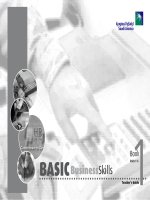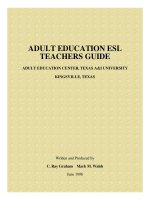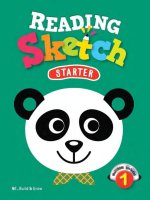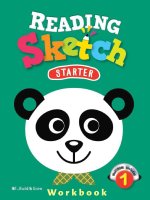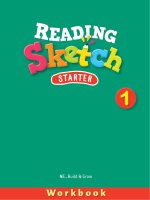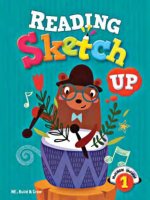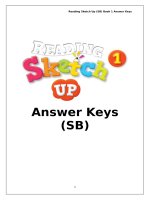Reading sketch 1 teachers guide
Bạn đang xem bản rút gọn của tài liệu. Xem và tải ngay bản đầy đủ của tài liệu tại đây (787.76 KB, 101 trang )
Reading Sketch 1
Teacher's Guide
Build your dreams, Grow as a global leader
www.ibuildandgrow.com
Unit 1|
My Family
Reading Sketch:Teacher’s’sGuide
Unit Objectives: Students will
1. To learn key family member vocabulary
2. To be able to use and understand the expression, “This is my grandfather.”
3. To practice reading comprehension and word recognition
Power Vocabulary:
brother, father, grandfather, mother, sister
LESSON GUIDE
Before Reading
Have your students look at the picture. Ask them to describe the picture. Who do
you see? Where are they? (A family at the beach)
Have the students read the ‘Get Ready’ text together.
Get the students engaged by asking, “Who does the writer like?” and “Who is
part of the family?”
Next, have the students list to each word and point to the word that they hear.
Then have them repeat each word. Have the students take turn reading each word.
To help the students understand the meaning of the key words ask, “What is your
grandfather’s name?” Do you have a brother?” If needed, draw an example
family tree to help students to visualize the relationship between members of
families.
Reading Sketch 1, Unit 1
1
During Reading
Have the students listen as they follow along in their books.
Let the students take turns reading the story out loud.
Extra Item:
Have the students read the story aloud. Have them take turns. (One student will
read one line, and then the next student will read one line, etc.) Then, choose one
student to come to the front of the classroom. Give them a piece of chalk or a
marker. Have them draw a picture like the one in the sand. Then have them read
the story according to THEIR real family. Give a few different students
opportunities to participate.
Have the students try to think back to the story. Ask the students to close their
books (keeping their place with a pencil).
1. Which family members did you hear about in the story?
2. What is grandfather like? Brother?
3. What is the difference between older and younger?
4. How did the girl describe her sister?
After Reading
Try it!
Question: How many people are in the girls drawing?
Have the students look at the drawing in the sand. Have them identify
each face. Where is the girl?
Mini Check Up
1. The girl has an older brother.
2. The girl has four family members.
Reading Sketch 1, Unit 1
2
Read each question true or false question. Give the students a moment to think.
Then, Read the question again. Have the students either show an O or X with
their arms.
Reading Comprehension
Have the students complete questions 1-3 based on the reading.
Give the students some tips:
Question 1:
Have the students read each possible answer together. Review each answer to
determine whether it is or is not the main idea of the story.
Questions 2 & 3:
Suggest that the students go back to the story and scan for key words like: kind,
or younger sister.
Pattern Talk
Have the students read the example sentences in the bubbles. Call on a student
and have them choose one of the words in the idea box to complete the sentence.
Then, give the students a few moments to work with a partner. Have the pairs
practice taking turns asking each other questions and answering.
Word Power
Have the students match the pictures to the words.
Check the answers. Ask the students to describe the picture.
Which picture has a father? Students: A man in a red shirt.
Your Turn
Have your students draw their family members in the frame. Have them write
their family members’ names on the line.
Extra Idea:
Engage your students by having them role-play. Divide students into groups of
five. Each of them will be a family member from the story. Give them time to
practice. Acting out actions (Mom will cook or hold a baby). One student will be
the main character, which will read the story.
ANSWER KEY: STUDENT BOOK
Reading Sketch 1, Unit 1
3
p. 8
Mini Check Up
1. T
2. F
p. 9
Reading Comprehension
1. a
2. b
3. a
p. 10
Word Power
1. brother
2. father
3. sister
ANSWER KEY: WORKBOOK
Reading Sketch 1, Unit 1
4
p. 2
Word Activity
◎
◎ 1. mother
2. grandfather
3. sister
4. brother
p. 3
Writing Practice
3. This is my mother.
4. This is my younger sister.
Dictation
grandfather / my / This / sister / family
Reading Sketch 1, Unit 1
5
Unit 2|
The Song Festival
Reading Sketch:Teacher’s’sGuide
Unit Objectives: Students will
1. To learn farm animal vocabulary
2. To be able to use and understand the expression, “The pig sings, “oink.”
3. To practice reading comprehension and word recognition
Power Vocabulary:
cow, duck, pig, rooster, sheep
LESSON GUIDE
Before Reading
Have your students look at the picture. Ask them to describe the picture.
Have the students read the ‘Get Ready’ text together.
Get the students engaged by asking, “What does the pig sing?” and “Who sings
with the pig?”
Next, have the students listen to each word and point to the word that they hear.
Then have them repeat each word. Have the students take turn reading each word.
To help review the animals say, “What’s this?”
Extra Item:
Put a picture of each animal on the board. Call two students to the front of the
classroom. Give each student a pointer. Then, say one of the animal names
(Teacher says, “It’s a cow.”) The students will then have to find the cow picture,
Reading Sketch 1, Unit 2
1
and point it out more quickly than their opponent. The student who finds the
animal the fastest will get a point.
During Reading
Have the students listen as they follow along in their books. Have them take turns
reading the story out loud.
Extra Item:
Assign one animal name to various students. Have all the students who were
assigned pig, read the line about the pig. Have the students who were assigned to
be ducks, read the line about ducks, and so on. Then, for the last line have all the
students read together.
Have the students try to think back to the story. Ask the students to close their
books (keeping their place with a pencil).
1. What farm animals did you hear about in the story?
2. What sound does the cow make? The sheep?
3. Who signs happy songs together?
After Reading
Try it!
Question: How many farm animals can you find in the picture?
Have the students look at the picture of the farm. Count together, saying the
names of the animals out loud.
Mini Check Up
1. The pig sings, “quack.”
2. The farm animals sing noisy songs.
Reading Sketch 1, Unit 2
2
Read each question O or X question. Give the students a moment to think. Then,
Read the question again. Have the students either show an O or X with their arms.
Reading Comprehension
Have the students complete questions 1-3 based on the reading.
Give the students some tips:
Question 1:
Have the students read each possible answer together. Review each answer to
determine whether it is or is not the main idea of the story.
Questions 2 & 3:
Suggest that the students go back to the story and scan for key words like: cocka-doodle-do, or have.
Pattern Talk
Have the students read the example sentences in the bubbles. Call on a student to
practice the conversation with you. Have them choose one of the words in the
idea box to complete the sentence.
Then, give the students a few moments to work with a partner. Have the pairs
practice taking turns asking each other questions and answering.
Word Power:
Have the students look at each picture and check the correct word.
Check the answers. What is the animal in picture number one? Students: It’s a
cow!
Your Turn
Have your students draw a picture of each of the animals that they learned about
in the story. Ask them to write what each animal sang above each animal.
Review by showing the animal pictures (from the pointer game) and saying, “The
cow sings _____.” The students will then say, “The cow sings “moo.”
Reading Sketch 1, Unit 2
3
ANSWER KEY: STUDENT BOOK
p. 12
Mini Check Up
1. F
2. F
p. 13
Reading Comprehension
1. c
2. c
3. c
p. 14
Word Power
1. cow
2. duck
3. sheep
Reading Sketch 1, Unit 2
4
ANSWER KEY: WORKBOOK
p. 4
Word Activity
◎
◎ 1. pig
2. sheep
3. duck
4. cow
p. 5
Writing Practice
3. The sheep sings, “baa.”
4. They sing happy songs together.
Dictation
pig / sings / sheep / rooster / sing
Reading Sketch 1, Unit 2
5
Unit 3|
My New School
Reading Sketch:Teacher’s’sGuide
Unit Objectives: Students will
1. To learn school vocabulary
2. To be able to use and understand the expression, “This is a nice playground.”
3. To practice reading comprehension and word recognition
Power Vocabulary:
cafeteria, classroom, playground, school, teacher
LESSON GUIDE
Before Reading
Have your students look at the picture. Ask them to describe the picture.
Have the students read the ‘Get Ready’ text together.
Get the students engaged by asking, “What is my new school like?” “Is my new
teacher nice?”
-Have the students list to each word and point to the word that they hear.
-Then have them repeat each word.
-Have the students take turn reading each word.
-To help the students understand the meaning of the key words ask, “What does
your classroom look like?” What is your teacher’s name?”
Reading Sketch 1, Unit3
1
During Reading
Have the students listen as they follow along in their books.
Let the students take turns reading the story out loud.
Extra Item:
Have the students read the story aloud. Have them take turns. (One student will
read one line, and then the next student will read one line, etc.) Then, choose one
student to come to the front of the classroom. Give them a piece of chalk or a
marker. Have them draw a picture like the one in the sand. Then have them read
the story according to THEIR real family. Give a few different students
opportunities to participate.
Have the students try to think back to the story. Ask the students to close their
books (keeping their place with a pencil).
1. Which family members did you hear about in the story?
2. What is grandfather like? Brother?
3. What is the difference between older and younger?
4. How did the girl describe her sister?
After Reading
Try it!
Question: What things can you see at your school?
Have the students look closely at the picture, trying to identify the things that
they too have in their schools.
Extra Item:
Have the students change the words in the story to fit their own schools.
Example:
I love my elementary school.
Reading Sketch 1, Unit3
2
There are nice trees.
There is a nice bathroom.
Mini Check Up
1. The boy loves his old school.
2. There is a nice playground at the boy’s new school.
Read each question true or false question. Give the students a moment to think.
Then, Read the question again. Have the students either show an O or X with
their arms.
Reading Comprehension
Have the students complete questions 1-3 based on the reading.
Give the students some tips:
Questions 1&3:
Have the students read each possible answer together. Review each answer to
determine whether it is or is not the main idea of the story.
Question 2:
a)Suggest that the students go back to the story and scan for key words like:
There is
Pattern Talk
Have the students read the example sentences in the bubbles. Call on a student
and have them choose one of the words in the idea box to complete the sentence.
Then, give the students a few moments to work with a partner. Have the pairs
practice taking turns asking each other questions and answering.
Word Power:
Have the students complete each word by choosing the missing letter from the
tan box.
Check the answers. Choose students to read the spelling aloud or to write the
word on the board.
Your Turn
Have your students draw their school. Tell them to think, “What is there in my
school?”
Extra Idea:
Reading Sketch 1, Unit3
3
Engage your students by having them do an information gap activity with a
partner. Have each student take out a piece of notebook paper. Keeping the
drawing of their school hidden, each partner will ask, “Is there a nice ________
in your school?” If there were a cafeteria in their partner’s school, the partner ho
asked the question would then draw a school with a cafeteria in it on their paper.
The object of this activity is to draw a picture similar to their partners original
picture, without showing their partner their picture (Your turn).
ANSWER KEY: STUDENT BOOK
p. 16
Mini Check Up
1. F
2. T
p. 17
Reading Comprehension
1. a
2. c
3. b
p. 18
Word Power
1. y
2. c
3. r
ANSWER KEY: WORKBOOK
Reading Sketch 1, Unit3
4
p. 6
Word Activity
◎
◎ 1. cafeteria
2. playground
3. school
4. teacher
p. 7
Writing Practice
3. There is a nice cafeteria.
4. There is a nice classroom.
Dictation
school / playground / There / classroom / teachers
Reading Sketch 1, Unit3
5
Unit 4|
Sweet Fruits
Reading Sketch:Teacher’s’sGuide
Unit Objectives: Students will
1. To learn fruit vocabulary
2. To be able to use and understand the expression, “It’s an apple. It’s big.”
3. To practice reading comprehension and word recognition
Power Vocabulary:
apple, banana, fruit, strawberry, watermelon
LESSON GUIDE
Before Reading
Have your students look at the picture. Ask them to describe the picture.
Have the students read the ‘Get Ready’ text together.
Get the students engaged by asking, “What color is it?” “What is it?”
-Have the students list to each word and point to the word that they hear.
-Then have them repeat each word.
-Have the students take turn reading each word.
-To help the students understand the meaning of the key words ask, “What does
watermelon look like?” What color is a banana?”
Reading Sketch 1, Unit 4
1
During Reading
Have the students listen as they follow along in their books.
Let the students take turns reading the story out loud.
Have the students try to think back to the story. Ask the students to close their
books (keeping their place with a pencil).
1. What are there many of?
2. What is small?
3. Are they all sweet?
After Reading
Try it!
Question: What fruits can you see in the picture? Say which your favorite is.
Have the students look closely at the picture, trying to identify which fruit is their
favorite. They may also identify which fruits they like and don’t like.
Extra Item:
Play ‘pass the fruit’ with the class. Distribute a picture of each fruit to a few
random members of the class. Have the class read the story together. The teacher
will press the bell, and say a fruit. The students will stop passing and reading, and
the student with the fruit that was named will stand up. If they can recite the part
of the story (without looking) about that fruit, then that student will get a point.
Example: The teacher says banana. The student stands up and says, “It’s a
banana. It’s big.”
Mini Check Up
1. The apple is big.
2. The watermelon is big.
Reading Sketch 1, Unit 4
2
Read each question true or false question. Give the students a moment to think.
Then, Read the question again. Have the students either show an O or X with
their arms.
Reading Comprehension
Have the students complete questions 1-3 based on the reading.
Give the students some tips:
Questions 1&3:
Have the students read each possible answer together. Review each answer to
determine whether or not it fits.
Question 2:
Suggest that the students go back to the story and scan for the word small.
Pattern Talk
Have the students read the example sentences in the bubbles. Call on a student
and have them choose one of the words in the idea box to complete the sentence.
Ask the student, “What’s this?” Then have the student respond.
Give the students a few moments to work with a partner. Have the pairs practice
taking turns asking each other questions and answering.
Word Power
Have the students complete each word by choosing the missing letter from the
tan box.
Check the answers. Choose students to read the spelling aloud or to write the
word on the board.
Your Turn
Draw a fruit sandwich on the board. Then ask your students draw their fruit
sandwich in their books. Finally, have them write the names of the fruits they
used in the recipe.
Extra Idea:
To summarize Unit 4, play a game with the class. Choose two students. Have one
student stand with their back facing the board. Have the other student draw a
picture of a fruit (with colors). Make sure that the student with their back to the
board can’t see the picture. Have the remaining students give the student who is
guessing some hints. The hints cannot include the name of the fruit. The class
will try to help the guessing student guess all the fruit names within 15 seconds.
Reading Sketch 1, Unit 4
3
ANSWER KEY: STUDENT BOOK
p. 20
Mini Check Up
1. T
2. T
p. 21
Reading
Comprehension
1. a
2. a
3. a
p. 22
Word Power
1. f
2. n
3. b
Reading Sketch 1, Unit 4
4
ANSWER KEY: WORKBOOK
p. 8
Word Activity
◎
◎ 1. apple
2. banana
3. watermelon
4. fruit
p. 9
Writing Practice
3. It’s a big watermelon.
4. They are all sweet.
Dictation
fruits / apple / small / banana / sweet
Reading Sketch 1, Unit 4
5
Unit 5|
The Shoemaker and the Elves
Reading Sketch:Teacher’s’sGuide
Unit Objectives: Students will
1. To learn clothing vocabulary
2. To be able to use and understand the expression, “I can see a pair of shoes.”
3. To practice reading comprehension and word recognition
Power Vocabulary:
elf, magic, pants, shirt, shoe
LESSON GUIDE
Before Reading
Have your students look at the picture. Ask them to describe the picture.
Have the students read the ‘Get Ready’ text together.
Get the students engaged by asking, “Who can make shoes?” “How do they make
them?”
-Have the students list to each word and point to the word that they hear.
-Then have them repeat each word.
-Have the students take turn reading each word.
-To help the students understand the meaning of the key words ask, “Who uses
magic?” What does an elf look like?”
Reading Sketch 1, Unit 5
1
During Reading
Have the students listen as they follow along in their books. Let them take turns
reading the story out loud.
Have the students try to think back to the story. Ask the students to close their
books (keeping their place with a pencil).
1. What can the writer see?
2. How many elves are making the shoes?
3. Who made the nice shirts and pants?
After Reading
Try it!
Question: How many shoes can you find in the picture?
Have the students look closely at the picture, counting how many shoes are in the
picture. Give the students a moment to count on their own. Then ask them how
many they found.
Extra Item:
Divide the class into small groups. Instruct each group to come up with their own
version of the story.
Example: I can see two more pairs of glasses.
I can see three more pairs of glasses.
It’s wonderful!
Choose a few groups to present their stories to the class.
Mini Check Up
1. Two little elves are making shoes.
2. They can make nice hats for two elves.
Reading Sketch 1, Unit 5
2
Read each question true or false question. Give the students a moment to think.
Then, Read the question again. Have the students either show an O or X with
their arms.
Reading Comprehension
Have the students complete questions 1-3 based on the reading.
Give the students some tips:
Questions 1&3:
Have the students read each possible answer together. Review each answer to
determine whether or not it fits.
Question 2:
Suggest that the students go back to the story and scan for the sentence: “Who is
making all the shoes?” The answer to that question will show them the correct
answer.
Pattern Talk
Have the students read the example sentences in the bubbles. Call on a student
and have them choose one of the words in the idea box to complete the sentence.
Ask the student, “What can you see? Then have the student respond.
Give the students a few moments to work with a partner. Have the pairs practice
taking turns asking each other questions and answering.
Word Power
Have the students draw a line from the picture to the correct matching word.
Have the students check their partners’ answers.
Your Turn
Have the students choose their favorite part of the story. Have them write it in the
little book. Finally, let the students fill in the missing words in the story summary.
Extra Idea:
Have each student take out a blank sheet of paper. Ask them to think of what
they would like to use magic to do. Then have them draw a picture of what they
would do with magic. At the bottom of the picture have them write, “What can
you make?” I can make _________!
Reading Sketch 1, Unit 5
3
ANSWER KEY: STUDENT BOOK
p. 24
Mini Check Up
1. T
2. F
p. 25
Reading Comprehension
1. c
2. a
3. c
p. 26
Word Power
1. pants
2. shoe
3. magic
Your Turn
elves / shoes / magic / shirts / pants
Reading Sketch 1, Unit 5
4

